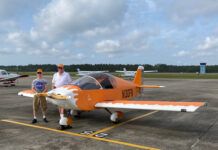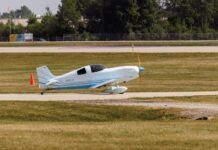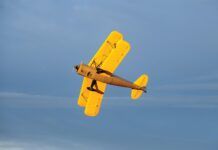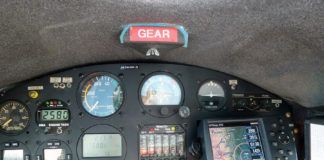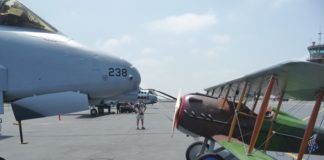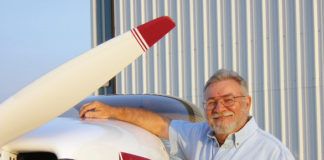When the Wright brothers achieved success with their 1903 Flyer, aside from their triumph with three-axis control, one of the reasons for their performance had to do with getting the power-to-weight ratio right. In other words, they finally figured out how to make their flying machine light enough that the available power from their engine had enough oomph to lift it off the ground (with the help of their airfoil research, of course). Ever since that day, building airplanes has been a matter of achieving lightness in all aspects of construction—lightness appropriate for the mission of the airplane, of course.
There is no doubt that the lighter the airplane, the better it performs (for a given horsepower), and the better it generally seems to handle. Rate of climb, in particular, is a function of weight and excess horsepower (the amount of horsepower available above what is required to maintain level flight). Therefore, the lighter the airplane, the better it climbs. Bert Rutan’s famous quote, “Throw the part up into the air—if it comes back down, it is too heavy to put on the airplane,” is a reminder that building in lightness is a virtue. When I tell Richard VanGrunsven how much I enjoy our fully IFR traveling RV-3, he gives me a gentle smile and says, “Wait until you fly a light one!” Yes, weight in construction is an important consideration no matter what you are building.

I was thinking about this as I read yet another thread on an Internet forum asking people to post the weight of a particular model of homebuilt airplane. My first thought was that the first liar hasn’t got a chance, since no matter what one builder posts, someone else will come along and post a smaller number. That’s how important weight control is to pilots. The truth is, weight reduction is not a simple matter of shaving every ounce off of every part of an airframe—for what matters is all-up flying weight for the particular aircraft. And there are several ways in which you can reduce that takeoff weight, some making a significant difference, others, not so much.
In general, it is safe to assume that most designers understand the importance of weight reduction, and therefore, they have designed the structure of the airplane to be as light as possible to fulfill the structural mission of the airframe. An aerobatic machine needs more beef than a cross-country cruiser, for instance, and therefore might have a little more inherent weight in the metal, wood, or composite. This is important for builders to remember, since trying to cut weight out of the primary structure will probably decrease the overall strength of the machine. Structures do fail occasionally—and it is not uncommon to trace those failures back to an unapproved alteration to the airframe design.
On the other hand, many kits or plans show optional lightening holes, places where a builder can choose to remove material while still maintaining design margins. Anecdotal evidence shows that this can save several pounds on an RV-6 airframe—one that will weigh in the neighborhood of 1,000 lb. when finished. Three pounds is a pretty small percentage of overall weight many argue, and it is true that it’s hard to build lighter by removing a little bit of metal, especially when you consider the time and effort involved.
When this topic comes up, it is quickly and often pointed out that there are very few modern-day humans who cannot afford to lose ten pounds or more. Doing so leads to a healthier body, better lifestyle—and lighter takeoff weights. When the airplane, leaves the ground, its weight is a combination of airframe, engine, fuel, and occupants. And the laws of physics don’t care what the individual components might be. So shaving a pound or three off the airframe while neglecting the size of the occupants seems to be a betrayal of the claim that a person is trying to “build light.”
But does this mean that weight savings are futile if the builder/pilot is unwilling to pass on that double cheeseburger and large fries? No, it doesn’t. It might be a bit disingenuous—but not futile—for every pound that you can save (while still meeting the airplane’s requirements) is a pound saved, regardless of where it comes from. Notice that I added the caveat, “while still meeting the airplane’s requirements.” If your goal is a basic, light-as-possible, day-VFR machine that will be flown in sight of the airport for aerobatic competition, then throw out the instruments altogether. There’s also no need for a GPS, forget the lights, and heck, go ahead and hand prop it to save the poundage of a starter and electrical system. Do that, and you also won’t need a transponder!
But if your goal is all-weather transportation, then you need some avionics and instrumentation, plus seats you are willing to occupy for reasonable flight legs, and maybe even a cup holder or two. Just realize that adding those things comes at a cost in weight—and therefore performance and handling characteristics. Building light has its costs, and is part of the design trade-offs when putting an airplane package together.
That RV-3 of ours? Absolutely the most delightful airplane I have ever flown. Wonderful handling, remarkable performance, and one of the heavier RV-3’s ever built. We make up for it with added horsepower and a constant-speed prop, but we are still carrying around 50 pounds of avionics and a comfy seat so that we can use it as fast personal transportation across the continent. We talk of building another one with nothing inside but an airspeed indicator and altimeter (and maybe a seat cushion out of a boat), and someday, we might do that if what we want is a purely local aerobatic machine. The weight of the airplane is all about the choices we make, and what the airplane needs to do.
So the next time someone challenges you to a duel of whose airplane is the lightest, remember that the empty weight number alone doesn’t tell the whole story. You have to relate what the airplane was designed for to put it in context. Meanwhile, it doesn’t hurt to look at the weight that you add to the airplane—and what you carry on a routine basis. How much does that cross-country tool bag weigh, for instance? Do you carry a couple quarts of oil on a trip? What about a canopy cover? And do they stay in the airplane, even when you’re flying locally? Uhh…why?
Weight matters—but it comes from many places. If you spend a lot of money and time to save a pound and then carry more than you need, you have wasted that time and money. Save the weight wherever you can if lightness is important, because all of the ounces do add up. No matter if they are in the structure, the panel, the seats, or your paunch. Just look at the big picture when you build, and do what makes sense, no matter what the other liars might say about their airplane’s weight. And if it really bothers you—ask them if their scales were certified.






